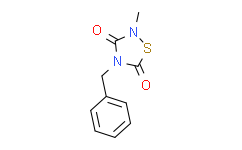 ( 母液浓度为 40 mg/mL ), 如您需要配置的浓度超过该产品的溶解度,请先与我们客服联系。
( 母液浓度为 40 mg/mL ), 如您需要配置的浓度超过该产品的溶解度,请先与我们客服联系。| 中文名称: | TDZD-8 一键复制产品信息 | ||||
|---|---|---|---|---|---|
| 英文名称: | TDZD-8 | ||||
| 别名: | 4-Benzyl-2-methyl-1,2,4-thiadiazolidine-3,5-dione | ||||
| CAS No: | 327036-89-5 | 分子式: | C10H10N2O2S | 分子量: | 222.26 |
| CAS No: | 327036-89-5 | ||||
| 分子式: | C10H10N2O2S | ||||
| 分子量: | 222.26 | ||||
| MDL: | MFCD04973552 | ||||
基本信息
|
产品编号: |
T80005 |
||||
|
产品名称: |
TDZD-8 |
||||
|
CAS: |
327036-89-5 |
储存条件 |
粉末 |
2-8℃ |
四年 |
|
|
|
||||
|
分子式: |
溶于液体 |
-80℃ |
6个月 |
||
|
分子量: |
222.26 |
-20℃ |
1个月 |
||
|
化学名: |
4-Benzyl-2-methyl-1,2,4-thiadiazolidine-3,5-dione |
||||
|
Solubility (25°C): |
|||||
|
体外:
|
DMSO |
44.5mg/mL (200.21mM) |
|||
|
Ethanol |
44.5mg/mL (200.21mM) |
||||
|
Water |
Insoluble |
||||
|
体内(现配现用): |
1.请依序添加每种溶剂:10% DMSO→40% PEG300→5% Tween-80→45% saline Solubility:≥2.5mg/mL(11.25mM);Clear solution |
||||
|
此方案可获得 ≥ 2.5 mg/mL (11.25 mM,饱和度未知) 的澄清溶液。 以 1 mL 工作液为例,取 100 μL 25.0 mg/mL 的澄清 DMSO 储备液加到 400 μL PEG300 中,混合均匀;向上述体系中加入50 μL Tween-80,混合均匀;然后继续加入 450 μL生理盐水定容至 1 mL。 |
|||||
|
2.请依序添加每种溶剂:10% DMSO→90%(20% SBE-β-CD in saline) Solubility:≥2.5mg/mL(11.25mM);Clear solution |
|||||
|
此方案可获得 ≥ 2.5 mg/mL (11.25 mM,饱和度未知) 的澄清溶液。 以 1 mL 工作液为例,取 100 μL 25.0 mg/mL 的澄清 DMSO 储备液加到 900 μL 20% 的 SBE-β-CD 生理盐水水溶液中,混合均匀。 |
|||||
|
3.请依序添加每种溶剂:10% DMSO→90% corn oil Solubility:≥2.5mg/mL(11.25mM);Clear solution |
|||||
|
此方案可获得 ≥ 2.5 mg/mL (11.25 mM,饱和度未知) 的澄清溶液,此方案不适用于实验周期在半个月以上的实验。 以 1 mL 工作液为例,取 100 μL 25.0 mg/mL 的澄清 DMSO 储备液加到 900 μL玉米油中,混合均匀 |
|||||
|
<1mg/ml表示微溶或不溶。 |
|||||
|
普西唐提供的所有化合物浓度为内部测试所得,实际溶液度可能与公布值有所偏差,属于正常的批间细微差异现象。 |
|||||
|
请根据产品在不同溶剂中的溶解度选择合适的溶剂配制储备液;⼀旦配成溶液,请分装保存,避免反复冻融造成的产品失效。 |
|||||
制备储备液
|
浓度
溶液体积 质量 |
1mg |
5mg |
10mg |
|
1mM |
4.4992mL |
22.4962mL |
44.9924mL |
|
5mM |
0.8998mL |
4.4992mL |
8.9985mL |
|
10mM |
0.4499mL |
2.2496mL |
4.4992mL |
生物活性
|
产品描述 |
一种选择性的GSK-3抑制剂。 |
|
靶点 |
GSK-3β 2μM (IC50) |
|
体外研究 |
TDZD8 results in a significant decline of cellular ATP levels in PC-3 cells.TDZD8 (10μM) treatment also triggers a drastic autophagy response and AMPK activation in PC-3 cells.Furthermore,TDZD8 (10μM) reduces mTOR phosphorylation levels at the S2448 site.In addition,TDZD8 (10μM) induces LKB1 nuclear-cytoplasm translocation. |
|
体内研究 |
TDZD-8 (TDZD8,1 or 2mg/kg,i.p.) both reduces the induction of p-DARPP32 following chronic L-dopa treatment in parkinsonian animals.TDZD8 treatment of 21 days induces a significant reduction in PKA expression in rats with established dyskinesia.Moreover,TDZD8 reduces FosB mRNA level in the striatum and lowers the expression of PPEB mRNA to similar levels as in 6-OHDA-lesioned rats without treated with L-dopa.The decrease in dyskinesia induced by TDZD8 is overcome by dopamine rceptor-1 agonist. |
推荐实验方法(仅供参考)
|
激酶实验: |
|
GSK-3 activity is assayed in 50 mM Tris-HCl, pH 7.5,10mM MgCl2,1mM EGTA,and 1mM EDTA buffer,at 37℃,in the presence of 15μM GS-1 (substrate),15μM [γ-32P]ATP in a final volume of 12μL.After 20 min incubation at 37℃,4μL aliquots of the supernatant are spotted onto 2×2 cm pieces of Whatman P81 phosphocellulose paper, and 20s later,the filters are washed four times (for at least 10 min each time) in 1% phosphoric acid.The dried filters are transferred into scintillation vials,and the radioactivity is measured in a liquid scintillation counter.Blank values are subtracted,and the GSK-3β activity is expressed in picomoles of phosphate incorporated in GS-1 per 20 min or in percentage of maximal activity. |
|
动物实验: |
|
|
Apomorphine hydrochloride is administered (0.5mg/kg).L-dopa (25mg/kg) plus benserazide-HCl (6.25mg/kg) are given once-daily.TDZD8,a non-ATP competitive inhibitor of GSK-3β,is dissolved in 10% DMSO and is administered i.p.(TDZD8-L group,1mg/kg;TDZD8-H group,2mg/kg,respectively) 30 min prior to L-dopa intake for 3 weeks.(±)-1-Phenyl-2,3,4,5-tetrahydro-(1H)-3-benzazepine-7,8-diol hydrochloride (SKF38393),a D1 Dopamine receptor agonist,is dissolved in saline and is administered i.p.(SKF38393-L group,5mg/kg;SKF38393-H group,10mg/kg,respectively) 30 min prior to L-dopa intake for 3 weeks. |
|
本计算器可帮助您计算出特定溶液中溶质的质量、溶液浓度和体积之间的关系,公式为:
质量 (g) = 浓度 (mol/L) x 体积 (L) x 分子量 (g/mol)
摩尔浓度计算公式
用本工具协助配置特定浓度的溶液,使用的计算公式为:
开始浓度 x 开始体积 = 最终浓度 x 最终体积
稀释公式
稀释公式一般简略地表示为:C1V1 = C2V2 ( 输入 输出 )
(2).jpg)
 母液,添加 300 μLPEG300
母液,添加 300 μLPEG300 混匀澄清,再加 50μLTween80, 混匀澄清,再加 600μLSaline/PBS/ddH2O
混匀澄清,再加 50μLTween80, 混匀澄清,再加 600μLSaline/PBS/ddH2O 混匀澄清
混匀澄清方案所需的各种助溶剂如: DMSO , PEG300 / PEG400 , Tween 80 , SBE-β-CD , 玉米油 等, 均可点击跳转或在网站搜索购买。
计算结果:
工作液浓度: mg/ml;
DMSO母液配制方法: mg 药物溶于 μL DMSO溶液(母液浓度 mg/mL,
体内配方配制方法:取 μL DMSO母液,加入 μL PEG300,混匀澄清后加入μL Tween 80,混匀澄清后加入 μL Saline/PBS/ddH2O,混匀澄清。
1. 首先保证母液是澄清的;
2.
一定要按照顺序依次将溶剂加入,进行下一步操作之前必须保证上一步操作得到的是澄清的溶液,可采用涡旋、超声或水浴加热等物理方法助溶。





.png)





